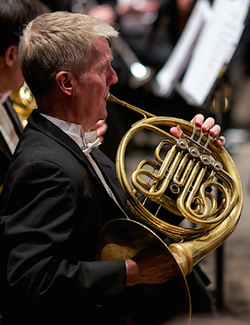
Photo credit: Terry Johnston
As stated in our bylaws, the duties of ICSOM President include the responsibility of supervising ICSOM’s conductor evaluation program. This is an area where I have had much experience, having served as the administrator of ROPA’s conductor evaluation bank for nearly ten years.
ICSOM’s conductor evaluation program had its origins exactly 50 years ago. In 1967, the results were hand-tabulated. Musicians were asked two questions on that historic form: “Do you, or would you like to play under this man as a guest conductor?” and “Do you, or would you like to play under this man as a permanent conductor?” By 1982, the language had evolved to be gender neutral, just in time for the milestone of the first female Music Director of a fully professional US orchestra—Catherine Comet, in 1986 in Grand Rapids. (Note: A great general resource for the history of ICSOM’s conductor evaluation program is Julie Ayer’s book, More Than Meets the Ear: How Symphony Musicians Made Labor History. A link is available here.)
It took nearly 15 years before computerized forms were used for ICSOM’s conductor evaluations. Cathy Compton, Emeritus member of the Detroit Symphony, is to be thanked for her work in developing ICSOM’s system with Wayne State University in 1982. That relationship between ICSOM and Wayne State continued for thirty years, until the university ceased its participation in September 2012 (when the professor who oversaw the project retired).
When Wayne State discontinued our program, ICSOM’s Governing Board formed a subcommittee to investigate options. In 2013, ICSOM Treasurer Michael Moore—at that time also the Administrator of the Conductor Evaluation Program—recommended that individual orchestras develop their own system to evaluate conductors.
Over the past few years, Cathy Compton and I met several times to discuss the history of ICSOM’s conductor evaluation program. The Governing Board has had ongoing discussions about what to do with all the archived material from the discontinued Wayne State program, all of which have now been transferred to Grand Rapids, Michigan.
In March 2017, ICSOM Delegates were surveyed about their interest and potential participation in an online Conductor Evaluation Program. The results of that survey led the Governing Board to include the topic for in-person discussion at last summer’s annual ICSOM conference, which occurred during a delegates-only session. As a result, the delegates passed a resolution calling for the creation of a pilot program for evaluating conductors and a report about the program at the 2018 conference. (Note: See “Resolutions” in the October 2017 issue)
The purpose of the program remains as before: to evaluate music directors and guest conductors of ICSOM orchestras, to give musicians of ICSOM a vehicle for providing data in a confidential way, to provide information to committees of ICSOM orchestras in a protected manner, and to respond to requests from OCSM and ROPA orchestras for conductor files. (As a result of resolutions adopted at their 1990 conferences, ICSOM, ROPA, and OCSM could access each other’s conductor evaluation information. Both ROPA and OCSM have active conductor evaluation banks today, with OCSM having moved to an online system in 2011.)
There are two main differences between ICSOM’s online system and the previous system with Wayne State. The obvious one is that we now will be administering the program electronically. The second difference is how the information will be sent, and to whom.
Because management agrees by submitting the release form that it will indemnify ICSOM, musicians, and others for liability arising from any breach of confidentiality, it makes sense that management should be the party that receives the information. To protect musicians and avoid potential legal liability, and out of ethical considerations, the information contained in the evaluation file is not to be posted or made available to the orchestra at large. It can be shared with any search committee members, who may include musician representatives, but the information will be under the control of the managers who have indemnified ICSOM. We are aware of managers in the past who would not use the conductor evaluation program because they were forced to accept legal responsibility yet were unable to see the file directly. The new system will alleviate that concern and place the file with the person who ultimately is responsible for it.
We have spent months creating an online conductor evaluation program for those ICSOM orchestras who wish to participate. By doing so, we also have created a position for handling this important and confidential work. I am pleased to announce that Barbara Corbató of the Grand Rapids Symphony will be the first Administrator of our online Conductor Evaluation Program.
To use the program, an ICSOM delegate will request a conductor evaluation survey from the Administrator, who will email to each musician a unique, one-time link to the survey. The survey will contain the standard set of questions from ICSOM’s previous evaluation program, with slight updates. The option of tailoring the survey to include a few additional questions specific to the orchestra’s needs is available. Once the surveys have been collected, and an evaluation file has been established, managements of ICSOM, OCSM, and ROPA (full member) orchestras can request the file for their use whenever hiring or renewing a conductor. This file would be sent to the manager electronically via a password-protected link from the Administrator.
Establishing the program has involved much time and preparation, for which I must thank Senza Sordino Editor Peter de Boor, Treasurer Michael Moore, ICSOM Counsel Kevin Case, and Conductor Evaluation Program Administrator Barbara Corbató. ICSOM’s online Conductor Evaluation Program will begin January 2018, and we are pleased to offer this option to orchestras that wish to participate.





